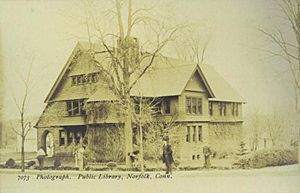Norfolk Library (Connecticut) facts for kids
The Norfolk Library, also known as Eldridge Memorial Library, is a special library located at 9 Greenwoods Road East in Norfolk, Connecticut. Even though it's a private organization, everyone can visit and use its resources. The library building was designed by architect George Keller in 1888 and made much bigger by him in 1911. It's a fantastic example of Shingle Style design. This building is an important part of the Norfolk Historic District.
Quick facts for kids |
|
|
The Norfolk Library
|
|
|
U.S. Historic district
Contributing property |
|
 |
|
| Location | 9 Greenwoods Road East Norfolk, Connecticut |
|---|---|
| Built | 1888-89 |
| Architect | George Keller |
| Architectural style | Shingle Style |
| Part of | Norfolk Historic District (ID79003749) |
| Designated CP | October 15, 1979 |
Contents
Building History and Design
The Norfolk Library was a gift from Isabella Eldridge. She donated the building to honor her parents. Her goal was to create a fireproof building. That's why it used tile shingles instead of wood ones. It was meant to be both a public library and a place for the community to meet.
George Keller, the architect, was from Hartford, Connecticut. He is most famous for designing war memorials. The building's cornerstone says "1888," but the library actually opened on March 6, 1889.
Architectural Features of the Original Building
The first floor of the library is made of red stone from Longmeadow, Massachusetts. The walls of the second story and the gables on the third story have unique fish-scale tile shingles. The front of the building, facing the street, looks a bit uneven. It has a large gable that connects to the porch roof. There's also a two-story half-turret and a small balcony on the second floor. Five windows on the first floor have pretty stained-glass tops. These windows light up the main desk area.
The original roof was made of Spanish tiles, matching the wall tiles. For a short time, it had asphalt shingles. But in 2016, money was raised to bring back the original Spanish tile roof. This project was finished in 2016. The small half-turret still has its original Spanish tile roof.
The main library room is a long, tall space. It has a wood barrel-vaulted ceiling, which looks like the inside of a barrel. On both sides of this room are two-story bookshelves made of red oak. A second-story walkway with a red-oak railing goes around three sides of the room.
In 1900, someone described the library like this: "The building was designed by Mr. George Keller. It is eighty-six feet long and forty-five feet wide, with two stories. The first floor has a reception hall, a reading room, a conversation room, and the main library room. This library room is very tall and wide, with a grand arch. When you enter, you see a bronze plaque on the wall. It says: 'IN REVERENT MEMORY OF JOSEPH AND SARAH ELDRIDGE'."
Expanding the Library: The 1911 Addition
Isabella Eldridge gave another donation, allowing Keller to make the building more than twice as big. He designed the new part to look like a small cathedral. The area that would be the "crossing" in a church became a longer part of the library room. The "transepts" (side sections) became two-story bookshelves on one side and a reading room with a fireplace on the other.
Instead of an "apse" (the rounded end of a church), Keller added the Great Hall. This is a large meeting room at the very end of the building. The Great Hall is also a tall, barrel-vaulted space with a gallery around it. It's even grander than the original building. This hall is used for meetings, talks, concerts, and art shows. Tall, white arches connect the different parts of the new addition.
The Smith Children's Room: 1985 Addition
In 1985, a one-story addition was built on the east side of the library. This part has a pyramidal-shaped roof and houses the Smith Children's Room. The architect, Alec Frost, was able to find the exact same type of stone from the same quarry. This meant the new addition matched the original library and the 1911 expansion perfectly.
How the Library Works
The Norfolk Library is a private, non-profit organization. It is managed by a group of people called a board of trustees. The Norfolk Library Associates is a volunteer group formed in 1974. They raise money to offer more services at the library. These services include lectures, book-signing events, and concerts.


